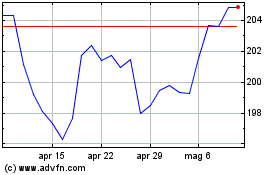Mercer, a business of Marsh McLennan (NYSE: MMC) and a global
leader in helping clients realize their investment objectives,
shape the future of work and enhance health and retirement outcomes
for their people, today released new research, Future of the U.S.
Healthcare Industry: Labor Market Projections by 2028. The report
projects a nationwide healthcare worker shortage of 100,000 by
2028.
Even before COVID-19, the US healthcare labor market faced
challenges with the demand for professionals in healthcare
occupations outpacing supply. Mercer’s new report highlights how
factors such as accelerated resignations, burnout among healthcare
workers, an aging population and wages that lag the broader labor
market are contributing to the decline in labor supply in certain
states, particularly for primary care physicians, advanced practice
providers1 and nurses.
“A shortage of 100,000 healthcare workers will exacerbate
existing disparities in healthcare access in certain states,” said
Dan Lezotte, a Partner in Mercer’s US Workforce Strategy and
Analytics Practice. “It is imperative that healthcare systems take
action and develop strategies to address shortages so patient care
is not impacted.”
The analysis emphasizes the importance of having a strong
workforce strategy to compete both with other healthcare
organizations and with employers in other industries. To combat
labor shortages, employers will need to develop comprehensive
strategic plans and innovative tactics for attracting and retaining
talent, encompassing strong compensation and benefits packages and
creative ways of sourcing talent, redesigning work, optimizing
schedules and more.
It is also crucial for healthcare systems and governments to
work together to address specific labor gaps across locations and
occupations, including subspecialties within healthcare labor, such
as physicians who specialize in women’s health or young children.
Through collaboration, states can close these gaps and create
stronger healthcare systems.
State disparities in primary care subspecialties
The analysis finds that access to qualified primary care will
vary across the US. Deficits in specialized primary care physicians
— such as obstetrician-gynecologists (OB-GYNs), pediatricians and
family medicine doctors — will be acute in certain states. For
example, despite an overall surplus of healthcare workers,
California is expected to face a shortage of over 2,500 primary
care physicians, with pediatricians and family medicine physicians
accounting for more than half of this shortage, creating barriers
to accessing specialized primary care.
A severe shortage of nursing assistants expected
nationally
Nursing assistants have the biggest projected deficit over any
other analyzed healthcare occupation, signaling the need to improve
talent attraction and retention strategies for this segment. By
2028, Mercer expects a projected deficit of over 73,000 nursing
assistants nationwide. The slow growth rate (0.1%) of nursing
assistants, particularly in states such as New York, Texas and
California, where shortages of over 11,000, 12,000 and 14,000
workers respectively are projected, will directly impact patient
care and the burnout and attrition rates of other healthcare
workers that depend on them.
Surplus of registered nurses (RNs) and home health and
personal care aides (HHAs)
At a national level, the supply of RNs is projected to outpace
demand, resulting in an estimated surplus of nearly 30,000 RNs by
2028. However, employers in states such as New York, New Jersey and
Connecticut will experience shortages and may look to Pennsylvania
for supply.
Encouragingly, the labor supply of HHAs is projected to exceed
demand nationally by almost 48,000 workers by 2028, with an average
annual growth rate of 3.4%. However, healthcare employers will be
competing with many other industries for these lower-wage workers
and may find it difficult to hire them unless wages are
competitive.
Nurse practitioners on the rise but shortages
expected
Nurse practitioners are expected to have the fastest growth rate
(3.5%). Despite this growth, however, the analysis projects a
nationwide shortage of nurse practitioners. The combined impact of
both nurse practitioner and physician shortages may disrupt
preventative care delivery in some states.
William Self, a Partner and Mercer’s Global Workforce Strategy
and Analytics Leader, said, “American healthcare workers are under
enormous strain. Burnout, under-compensation and wage stagnation
have had material impacts on the supply of healthcare labor.”
Mr. Self continued, “Prolonged inflation in healthcare costs,
combined with these critical labor shortages, could present an
existential threat to some healthcare systems. The inability to
attract the right healthcare labor will make operating in certain
locations much more difficult and increase health equity gaps, like
those between rural and urban populations.”
View an interactive map of Mercer’s US healthcare labor
projections across a sample of healthcare occupations here.
About the Report
The Future of the U.S. Healthcare Industry: Labor Market
Projections by 2028 provides a comprehensive examination of the
changing labor market for healthcare occupations across all 50
states, utilizing a combination of Mercer research, publicly
available data and data provided by Lightcast. Find more
information here.
About Mercer
Mercer, a business of Marsh McLennan (NYSE: MMC), is a global
leader in helping clients realize their investment objectives,
shape the future of work and enhance health and retirement outcomes
for their people. Marsh McLennan is a global leader in risk,
strategy and people, advising clients in 130 countries across four
businesses: Marsh, Guy Carpenter, Mercer and Oliver Wyman. With
annual revenue of $23 billion and more than 85,000 colleagues,
Marsh McLennan helps build the confidence to thrive through the
power of perspective. For more information, visit mercer.com, or
follow on LinkedIn and X.
1 Advanced practice providers, such as nurse practitioners or
physician assistants, perform medical activities typically
performed by a physician.
View source
version on businesswire.com: https://www.businesswire.com/news/home/20240829559938/en/
Media contact: Ashleigh Jang Mercer +1 917 647 0070
Ashleigh.Jang@Mercer.com
Grafico Azioni Marsh and McLennan Compa... (NYSE:MMC)
Storico
Da Ott 2024 a Dic 2024

Grafico Azioni Marsh and McLennan Compa... (NYSE:MMC)
Storico
Da Dic 2023 a Dic 2024
